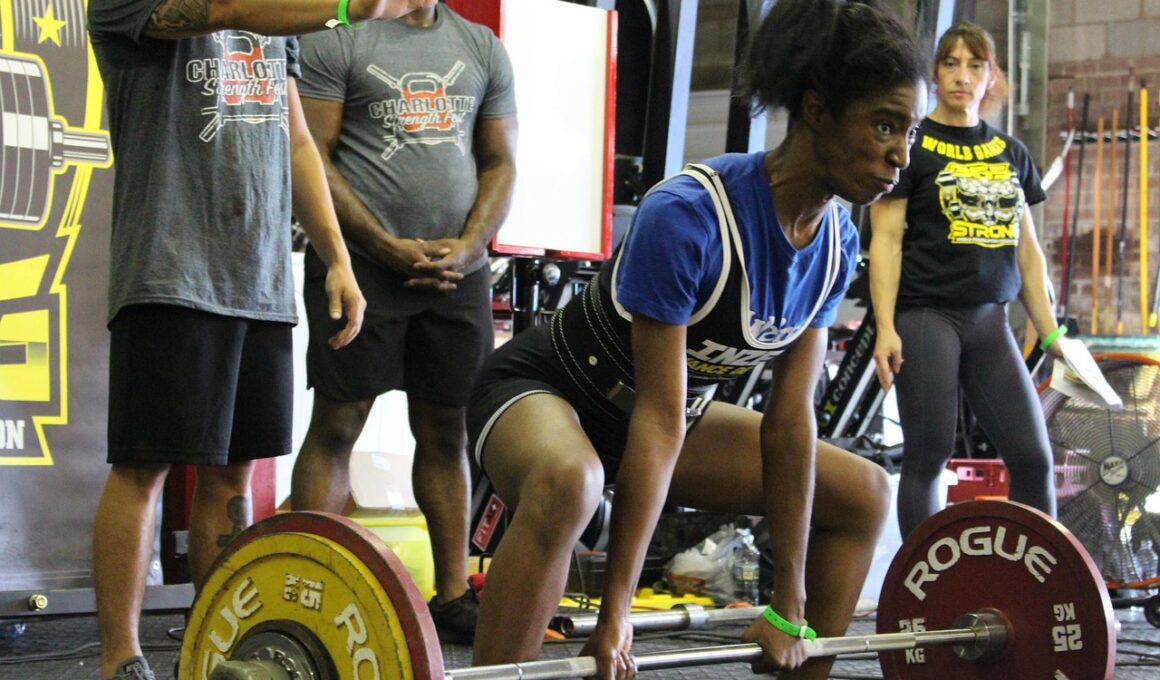The Science Behind Powerlifting: Muscle Engagement and Mechanics
Powerlifting is a strength sport focusing on three main lifts: the squat, bench press, and deadlift. Each of these lifts requires precise technique and unique muscle engagement. Understanding muscle mechanics enhances performance and minimizes injury risk. A powerlifter must harness the intended muscles to effectively complete each lift. In the squat, primary muscles like the quadriceps, hamstrings, and glutes engage during the upward phase. The bench press works the pectorals, deltoids, and triceps, while the deadlift predominantly engages the lower back, glutes, and hamstrings. An efficient lift is built on the coordinated contraction of these muscles, requiring optimal strength and technique. Proper engagement promotes efficacious lifting, ensuring maximum force generation. Focusing on mechanics also ensures energy conservation, allowing lifters to perform at higher levels. Hence, mastering each lift’s biomechanics is paramount for success in powerlifting. Lifters can enhance their performance if they comprehend and practice various engagement techniques. Begin by working on form and technique before increasing weight. Once the fundamentals are solid, lifters can focus on advancing to heavier weights, which is critical for progression in powerlifting.
In every successful powerlifting program, understanding the significance of muscle engagement is essential. Each lift has its unique demands, and lifters should familiarize themselves with their body’s biomechanics. Proper assessment of muscle activation during training sessions provides insights into weaker links that need strengthening. Regularly practicing the lifts will enhance neuromuscular coordination, which facilitates smooth execution during competitions. For example, employing variations such as pauses, tempo training, or incorporating bands are effective strategies to improve muscle engagement in critical areas. Lifters may also benefit from using visualization techniques to mentally prepare for lifts, fostering a mind-muscle connection. Over time, consistent practice ensures that an athlete can summon the right muscle groups whenever they lift. Training under the supervision of experienced coaches may also enhance performance. Coaches can correct form and ensure that specific muscles are engaged effectively. This valuable feedback system improves training outcomes and provides motivating reinforcement. Lifters should never overlook the importance of rest and recovery for optimal muscle adaptation, allowing time for growth. Prioritize active recovery techniques to optimize lifting performance over time.
Proper Technique in Powerlifting
Proper technique profoundly impacts the effectiveness of powerlifting. Each lift must be executed correctly to mitigate injury risk and maximize performance outcomes. This technical mastery also assists in muscle engagement; incorrect form may lead to ineffective activation. For instance, during the squat, maintaining a neutral spine and engaging the core is vital. Inadequate form can shift the stress onto the back instead of distributing it evenly across leg muscles. Similarly, when bench pressing, ensure that your shoulder blades are retracted and your feet are grounded. This positioning helps stabilize your body, promoting optimal power transfer from the chest to the barbell. Additionally, some lifters may overlook the significance of grip positions. For instance, a wider grip can engage different muscle groups during the bench press. Each powerlifting movement has varying grip widths, foot placements, and stances. Therefore, investing time in refining form and technique is indispensable. Lifters should record their lifts periodically to pinpoint issues in their form, using these insights for adjustments during training. Over time, consistent practice with refined techniques will enhance strength, skill level, and overall powerlifting success.
Fatigue management is another crucial aspect that influences muscle engagement during powerlifting. Competitors must recognize the link between fatigue and performance, and how muscle recruitment diminishes as fatigue sets in. Learning to identify these signs of fatigue can help lifters adjust their training programs accordingly. For example, the intensity and volume of workouts may vary as lifters approach competition days. A common practice is known as tapering, where lifters reduce their training volume while maintaining intensity as they prepare for a competition. This technique helps ensure muscles are well-rested and fully prepared to engage powerfully during their final attempts. Lifters should also focus on energy systems used during powerlifting. In powerlifting, the phosphagen energy system is crucial during maximal lifts. Therefore, it’s essential to incorporate proper rest intervals into training. Longer rest periods can facilitate more prolonged muscle engagement, effectively enabling lifters to lift heavier. Balance training loads and incorporate active recovery methods such as mobility work into the off days to maintain workout efficacy. By managing fatigue, lifters can consistently enhance lift performance and engage muscles effectively throughout all phases of training.
Injury Prevention and Recovery
Injury prevention is paramount in powerlifting, especially for novice and seasoned lifters alike. Proper warm-ups preceding each session are critical for preparing muscles and joints. Gradually increasing the weight during workouts allows the body to adjust without risking strains or injuries. Similarly, employing exercises that target stabilizing muscles enhances balance, preventing injuries that could derail training. Lifters should incorporate mobility work and flexibility training into their routines. These components aid in maintaining joint health and ensure that muscle engagement remains effective. Furthermore, listen to your body; understanding when to take breaks is necessary in preventing overtraining and injuries. After a typical training cycle, deload weeks are encouraged to allow for muscle recovery. During this period, lifters reduce their training intensity and volume to facilitate recovery. Adequate sleep and nutritious meals also play vital roles in injury prevention and recovery. Adequate nutrition supports muscle repair, while sleep enhances overall performance. Lastly, communication with trainers and physicians regarding physical limitations is essential. Establishing a comprehensive approach toward injury prevention can help lifters engage their muscles effectively for decades of competition.
Nutrition and hydration are fundamental to ensuring effective muscle engagement in powerlifting. A well-balanced diet enables lifters to achieve their fitness goals while supporting energy levels necessary for intense training sessions. Key macronutrients include carbohydrates for energy, proteins for muscle repair, and fats for long-term endurance. Consuming adequate protein before and after workouts supports muscle recovery, promoting engagement in subsequent training sessions. Lifters should monitor their hydration levels, as dehydration can impair performance and reduce muscle activation. Water plays a crucial role in muscle function and performance. Therefore, developing strategies to ensure proper hydration before, during, and after training is vital. Supplementing with amino acids or creatine may also aid with muscle performance and recovery, although lifters should consult a healthcare professional before starting any supplements. Nutritional approaches like carb loading prior to competitions can have significant advantages, enhancing performance substantially. Understanding individual macronutrient needs can enhance muscle-building efforts. Lifters should keep a food diary to monitor intake and track their nutritional needs. By implementing proper nutrition and hydration strategies, lifters can optimize muscle engagement and improve lifting performance.
The Role of Mindset in Powerlifting
Lastly, the psychological aspect of powerlifting cannot be overlooked. Mental resilience plays a significant role in performance outcomes and muscle engagement. A positive mindset enhances motivation and focus, which are essential during consistent training and competitions. Visualization techniques can be very beneficial; imagining successful lifts can lead to improved physical performance. Developing mental strategies like affirmations or goal-setting enhances emotional stability, thus impacting muscle engagement positively. Recognizing personal progress and celebrating milestones acts as a motivational boost; fostering a sense of accomplishment is also critical. Lifters should regularly reflect on their performances, building a strong mental framework that supports daily training. Building a routine that incorporates mental preparation can greatly influence competition outcomes. Furthermore, seeking support from fellow lifters or coaches assists in managing stress and overcoming challenges in training or competition settings. The psychological impact of peer support can’t be understated; a friendly community facilitates knowledge exchange and insightful feedback. Therefore, creating a balanced approach, combining physical training, nutrition, and mental empowerment, fosters sustainable engagement for powerlifting competitors aiming for success.


